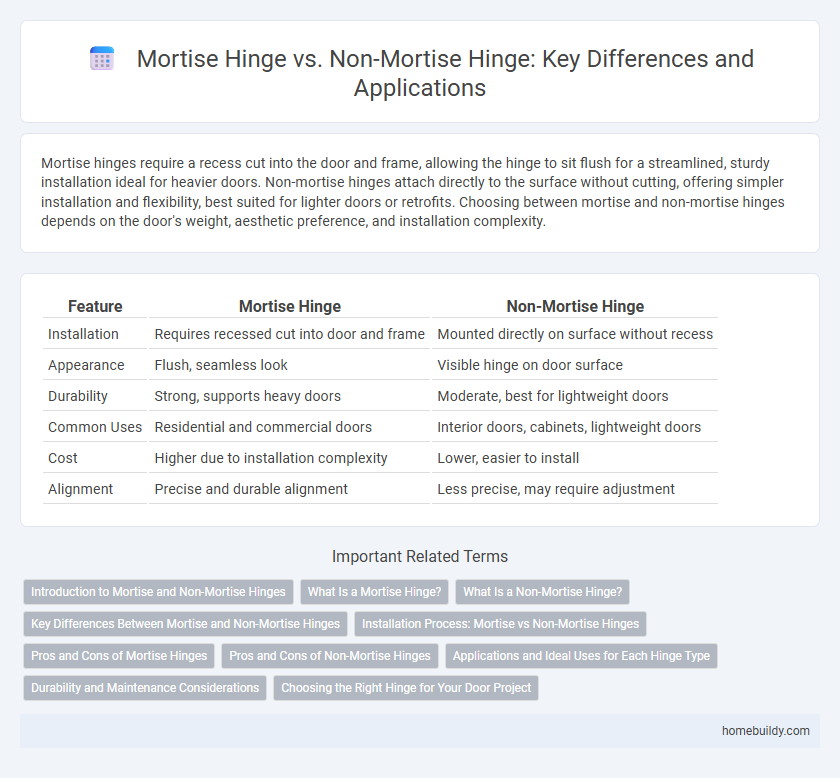Mortise hinges require a recess cut into the door and frame, allowing the hinge to sit flush for a streamlined, sturdy installation ideal for heavier doors. Non-mortise hinges attach directly to the surface without cutting, offering simpler installation and flexibility, best suited for lighter doors or retrofits. Choosing between mortise and non-mortise hinges depends on the door's weight, aesthetic preference, and installation complexity.
Table of Comparison
| Feature | Mortise Hinge | Non-Mortise Hinge |
|---|---|---|
| Installation | Requires recessed cut into door and frame | Mounted directly on surface without recess |
| Appearance | Flush, seamless look | Visible hinge on door surface |
| Durability | Strong, supports heavy doors | Moderate, best for lightweight doors |
| Common Uses | Residential and commercial doors | Interior doors, cabinets, lightweight doors |
| Cost | Higher due to installation complexity | Lower, easier to install |
| Alignment | Precise and durable alignment | Less precise, may require adjustment |
Introduction to Mortise and Non-Mortise Hinges
Mortise hinges are recessed into the door and frame, offering a flush fit that enhances stability and aesthetics. Non-mortise hinges mount directly onto the surface without requiring a cutout, simplifying installation but potentially protruding from the door edge. Choosing between mortise and non-mortise hinges depends on door style, installation complexity, and desired appearance.
What Is a Mortise Hinge?
A mortise hinge is a type of door hinge that requires a recess, or mortise, to be cut into the door edge and frame, allowing the hinge to sit flush and create a seamless appearance. This design offers enhanced stability and strength compared to non-mortise hinges, which attach surface-mounted without a recess and tend to protrude slightly. Mortise hinges are commonly used in residential and commercial settings where security, durability, and aesthetics are priorities.
What Is a Non-Mortise Hinge?
A non-mortise hinge is designed to be installed directly onto the surface of a door and frame without the need to cut or recess the wood. This type of hinge offers a simpler, quicker installation process compared to mortise hinges, which require precise chiseling to create a mortise pocket. Non-mortise hinges are ideal for lightweight doors or applications where ease of installation and minimal door modification are priorities.
Key Differences Between Mortise and Non-Mortise Hinges
Mortise hinges require a recess or pocket cut into the door and frame, allowing the hinge to sit flush, providing a cleaner aesthetic and stronger support for heavier doors. Non-mortise hinges install directly on the surface without cutting, making installation quicker and suitable for lighter doors or retrofit applications. Mortise hinges typically offer greater durability and load-bearing capacity, while non-mortise hinges prioritize ease of installation and versatility in various door types.
Installation Process: Mortise vs Non-Mortise Hinges
Mortise hinges require precise cutting of a recessed pocket in the door edge and frame for flush installation, ensuring a clean and secure fit. Non-mortise hinges attach directly to the surface without requiring recessing, allowing for quicker and less complex installation. Choosing between the two depends on the desired aesthetic and installation time, with mortise hinges offering a seamless look and non-mortise hinges providing ease of setup.
Pros and Cons of Mortise Hinges
Mortise hinges offer a flush, streamlined appearance by being embedded into the door and frame, providing enhanced stability and strength ideal for heavier doors. Installation requires precise chiseling, making it more time-consuming and demanding compared to non-mortise hinges, which simply screw onto the surface. Mortise hinges generally offer superior durability and load-bearing capacity but lack the ease of installation and adjustability found in non-mortise options.
Pros and Cons of Non-Mortise Hinges
Non-mortise hinges offer quick installation since they do not require recessing into the door or frame, making them ideal for retrofit projects and saving labor time. They provide sufficient support for lightweight and interior doors but may lack the strength and flush appearance of mortise hinges, potentially compromising durability and aesthetics on heavy or exterior doors. Limited adjustability and exposed hardware are common drawbacks, making non-mortise hinges less suitable for high-traffic areas or doors demanding a seamless finish.
Applications and Ideal Uses for Each Hinge Type
Mortise hinges are ideal for doors requiring a flush, concealed fit, commonly used in residential and commercial interior doors where aesthetic integration and durability are essential. Non-mortise hinges, designed for surface mounting without the need for recessing, are preferred for applications needing quick installation or where door frames cannot be altered, such as retrofit projects or metal doors. Each hinge type caters to specific structural and functional needs, making mortise hinges suitable for heavy, frequently used doors and non-mortise hinges best for lightweight or temporary installations.
Durability and Maintenance Considerations
Mortise hinges offer superior durability due to their recessed installation, which provides greater support and reduces stress on the door frame compared to non-mortise hinges. Non-mortise hinges, while easier to install, are generally less robust and may require more frequent maintenance to address loosening or misalignment. Choosing mortise hinges can lead to longer-lasting door functionality and less routine upkeep in high-traffic areas.
Choosing the Right Hinge for Your Door Project
Mortise hinges fit into a recessed cut in the door and frame, providing a flush, seamless appearance ideal for traditional wood doors and heavy-duty applications. Non-mortise hinges attach directly to the surface, simplifying installation and offering versatility for metal or temporary doors where cutting recesses is impractical. Selecting the right hinge depends on door material, aesthetic preference, load capacity, and installation complexity to ensure optimal functionality and durability.
mortise hinge vs non-mortise hinge Infographic

 homebuildy.com
homebuildy.com